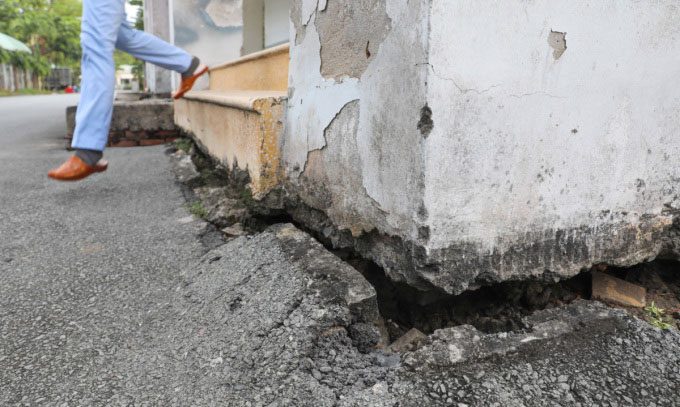A new study has revealed that several areas in 48 of the world’s most populous coastal cities are sinking rapidly, with Ho Chi Minh City experiencing an average subsidence of 16.2 mm per year.
The research team, led by Cheryl Tay from Nanyang Technological University, in collaboration with experts from NASA’s Jet Propulsion Laboratory and the Swiss Federal Institute of Technology Zurich (ETH Zurich), found evidence that certain regions in major coastal cities are sinking faster than sea levels are rising, as reported by New Scientist on September 19. The study was published in the journal Nature Sustainability.

The Mental Hospital in Binh Chanh District, Ho Chi Minh City, has serious subsidence, December 2020. (Photo: Quynh Tran).
In the new study, the experts used satellite radar to measure the subsidence rates of the 48 most populous coastal cities worldwide from 2014 to 2020. In 44 cities, the fastest-sinking areas are subsiding quicker than the rising sea levels. Cities in southern and Southeast Asia are among the fastest sinking locations. Certain areas in Tianjin (China) and Ahmedabad (India) are sinking more than 20 mm per year, while Ho Chi Minh City has an average subsidence rate of 16.2 mm annually.
In a case study focusing on Ho Chi Minh City, the experts discovered that an additional 20 km2 could be submerged and flooded if the current subsidence rate continues until 2030. Approximately 880 km2 would be below sea level if there were no land subsidence. The city of Rio de Janeiro (Brazil) could see an additional 2 km2 of flooding, increasing the flooded area by 16% compared to a scenario without subsidence.
However, according to expert Manoochehr Shirzaei from Virginia Tech, the elevation maps used in these case studies to estimate flooding levels are inaccurate in many areas worldwide, and focusing on rapidly sinking inland areas of cities rather than those right on the coast may have “exaggerated” the impact of subsidence.
Previously, a survey released in August by the Japan International Cooperation Agency (JICA) indicated that the ground in Ho Chi Minh City is sinking at an average rate of about 2 cm per year, with some areas experiencing up to 6 cm of subsidence.
The Southern Water Resource Planning and Investigation Federation (DWRPIS) also provided research data showing that the accumulated subsidence in Ho Chi Minh City from 2005 to 2017 was 23 cm, with the most subsidence occurring in An Lac Ward, Binh Tan District, at 81 cm; the average annual subsidence rate is 2 cm, with some areas reaching 6 cm. The ten districts with the highest subsidence are Districts 2, 7, 8, 12, Go Vap, Tan Binh, Binh Thanh, Phu Nhuan, Binh Tan, and Thu Duc, with Binh Tan and District 12 experiencing the most significant ground sinking.
A recent report from the Intergovernmental Panel on Climate Change (IPCC) regarding land level changes along coastlines worldwide over a century indicated a narrower range—the fastest subsidence rate is about 5.2 mm per year.
However, if the rapid subsidence rates observed in the new study continue, this could be a significant factor in the dangers associated with rising sea levels, according to Professor Robert Kopp from Rutgers University, who contributed to the IPCC report. “Land subsidence has always been considered a secondary issue. This new study may bring attention to this problem,” Shirzaei stated.



















































